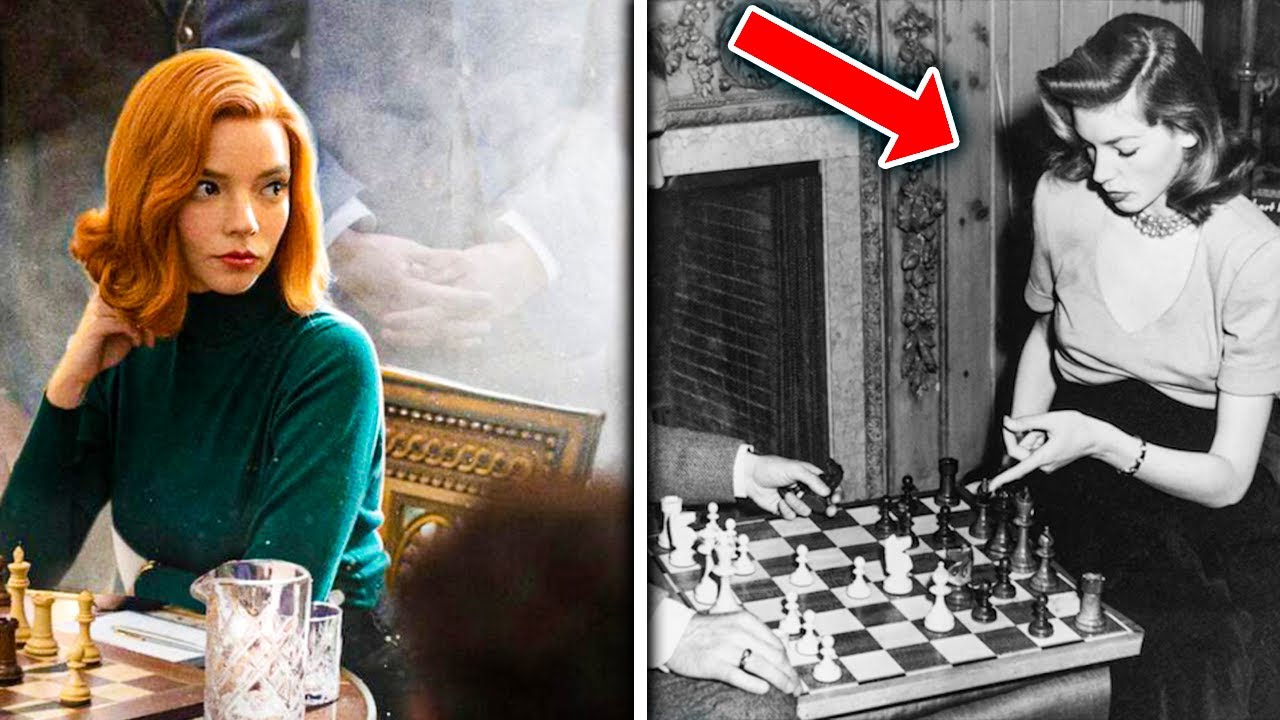Is The Queen’s Gambit Based on a true story? If you’re one of the millions of fans who binge-watched this hit Netflix series, you might be wondering if the story of a young chess prodigy, Beth Harmon, is based on a true story. Was Beth Harmon based on a real person? While the character of Beth Harmon is a work of fiction, many aspects of her story were inspired by real-life events. For example, her rise to prominence is loosely based on the life of American Chess Grandmaster Bobby Fischer. But that’s not all. Keep reading to find out more about the fascinating connections between The Queen’s Gambit and real life.
The Truth Behind The Queen’s Gambit: Fact or Fiction?
The Queen’s Gambit has become a global sensation and has garnered a massive following since its release. One of the most common questions that fans have about the show is whether it is based on a true story. While the character of Beth Harmon is a work of fiction, the show draws inspiration from real-life events.
The show’s narrative is loosely based on the life of Bobby Fischer, an American Chess Grandmaster who became the youngest player to win the US Championship at the age of 14. Fischer’s rise to prominence and his eventual fall from grace serve as the foundation for the show’s central character arc.
The show does not try to present itself as a biopic or a documentary, but rather as a fictionalized retelling of real-life events. The story is a testament to the enduring appeal of chess and the intense pressure that comes with competition at the highest level. It also explores themes of addiction, trauma, and redemption, making it a complex and nuanced portrayal of the human condition.
Overall, while The Queen’s Gambit is not directly based on a true story, it draws inspiration from real-life events and captures the spirit of the chess world in a compelling and engaging way.

🍿 Must Read Is The Woman King Based on a true story?
The Mystery Behind Whether Beth Harmon Was a Real Person
Elizabeth Harmon, the main protagonist in both the book and the Netflix drama miniseries of The Queen’s Gambit, is a fictional character. She was not based on any real person. However, it is worth noting that the author of the book, Walter Tevis, was a chess player himself, and some of the elements in the book are based on his own experiences playing chess.
Despite being a fictional character, Beth Harmon’s portrayal in the Netflix series by Anya Taylor-Joy received critical acclaim for her exceptional performance. She captured the character’s complexity and struggles with substance abuse and mental health issues with great sensitivity and depth.
While Beth Harmon may not have been based on a real person, her character resonated with many viewers who related to her struggles and her passion for chess. The show’s popularity has also sparked renewed interest in the game of chess, with many people inspired to take up the game or improve their skills.
Deconstructing Beth Harmon’s Character: Examining Possible Autism Traits
The portrayal of the main character, Beth Harmon played by Anya Taylor-Joy, is one of the reasons why “The Queen’s Gambit” is a powerful story. Although the show does not explicitly state that Beth is autistic, her character is heavily coded as such. The Netflix adaptation has received praise for its accurate portrayal of a character that is not explicitly given a diagnosis.
The show’s authenticity is one of its strongest aspects, and the portrayal of Beth Harmon is no exception. The attention to detail in her character’s mannerisms and behaviors make her relatable and genuine. The show’s creators have done an excellent job of portraying the daily struggles that people with autism face.
Many viewers have been curious about whether Beth Harmon is based on a real person, and if she had autism. While the show was not directly based on a true story, the character of Beth Harmon was inspired by real-life chess players. It is unclear if any of these players had autism or not. However, the show’s creators have made a conscious decision to code Beth’s character as autistic, which has added depth and complexity to her character.
In conclusion, although the show does not explicitly state that Beth Harmon is autistic, her character is heavily coded as such. This portrayal has added depth and authenticity to her character, making her relatable to many viewers. The show’s creators have done an excellent job of accurately portraying the struggles that people with autism face on a daily basis.
Unveiling the Real-Life Inspiration Behind the Queen’s Gambit Protagonist
The Queen’s Gambit is a Netflix series that has taken the world by storm. The show features the story of an orphan named Beth Harmon, who becomes a chess prodigy. However, what many people don’t know is that the series was largely inspired by true events. The show is based on the novel of the same name by Walter Tevis, who was a chess enthusiast himself. The book is said to have been inspired by the life of Bobby Fischer, who was a world-renowned chess player.
In the show, Beth Harmon is portrayed as a fictional character, but her life is based on the lives of real-life chess prodigies. One of the most significant inspirations for the character of Beth Harmon is a woman named Judit Polgár. Polgár is a Hungarian chess player who is widely considered to be one of the best female chess players of all time. She is also the only woman to have ever beaten a reigning world champion in an official game.
While the character of Beth Harmon is not directly based on Judit Polgár, her story is a significant inspiration for the character. Polgár’s childhood was similar to Beth’s, as she was also raised as a chess prodigy from a young age. Like Beth, Polgár faced numerous challenges and obstacles on her way to becoming one of the world’s best chess players.
In conclusion, while the character of Beth Harmon is fictional, she is based on the lives of real-life chess prodigies, including Judit Polgár. The show is a testament to the power of determination and hard work, and it is a tribute to those who have dedicated their lives to the game of chess.
>> Related – Is Amsterdam the movie a true story?
Understanding the Medication References in The Queen’s Gambit.
In The Queen’s Gambit, the protagonist Beth Harmon is seen taking white and green pills throughout the series. These pills, referred to as “xanzolam,” are not an actual medication but rather a fictional drug created for the show. Nonetheless, it is believed that the pills are supposed to represent tranquilizers such as Librium, which was a commonly prescribed medication in the 1960s for anxiety.
Librium, also known as chlordiazepoxide, belongs to a class of drugs known as benzodiazepines. These medications work by reducing the activity of certain chemicals in the brain, resulting in a calming effect on the body. They are known to be effective in treating symptoms of anxiety, insomnia, and alcohol withdrawal.
It is interesting to note that during the time period in which The Queen’s Gambit is set, benzodiazepines were often prescribed without much thought to the potential for addiction or abuse. However, in recent years, there has been growing concern over the widespread misuse of these medications, leading to increased regulations and awareness surrounding their use.
While the use of pills in the show may seem like an extreme portrayal of addiction, it is not entirely unrealistic. Many people struggle with addiction to prescription medications, and The Queen’s Gambit highlights the potential dangers and consequences of substance abuse. Overall, the show offers a thought-provoking commentary on the use and abuse of medication in our society.
Exploring Beth Harmon’s Mental Health Challenges.
Beth Harmon, the protagonist of the Netflix series “The Queen’s Gambit,” was a complex character who struggled with multiple disorders throughout her life. The show highlighted her difficult childhood experiences, which led to her developing depression and Posttraumatic Stress Disorder (PTSD) in her adulthood.
As a child, Beth suffered from abandonment, neglect, and abuse, which led to her developing severe depression. Her mother’s suicide and her father’s absence triggered her PTSD, causing her to have flashbacks and nightmares. She struggled to cope with her trauma and found solace in the game of chess, which became her escape from reality.
In her teenage years, Beth started to experiment with drugs, which were prescribed to her to help her stay focused during chess matches. However, her addiction to the pills soon took over her life, and she started to abuse them, leading to substance abuse disorder.
Overall, Beth’s character was a portrayal of someone who had experienced severe trauma and mental health issues. Her struggles with PTSD, depression, and substance abuse disorder were depicted in a realistic and sensitive manner, highlighting the importance of seeking help and support for mental health issues.
In conclusion, Beth Harmon’s character in “The Queen’s Gambit” suffered from multiple disorders, including PTSD, depression, and substance abuse disorder. The show sheds light on the impact of childhood trauma on mental health and emphasizes the importance of seeking help for mental health issues.

The Truth Behind The Queen’s Gambit: Separating Fact from Fiction
The Queen’s Gambit has been praised for its accuracy in depicting the world of chess and the competitive nature of the game. Although the character of Beth Harmon is fictionalized, the show’s narrative draws inspiration from real-life events. In particular, Beth’s journey to become a chess champion is loosely based on the life of American chess grandmaster, Bobby Fischer. Fischer was a prodigious talent who became the youngest player to win the United States Championship at the age of 14. He went on to win the World Chess Championship in 1972, defeating Soviet grandmaster Boris Spassky in what was dubbed the “Match of the Century.”
The show also accurately portrays the use of chess notation and strategy, as well as the intense pressure and mental strain that comes with competitive play. In addition, the show’s depiction of the Cold War-era political tensions between the United States and the Soviet Union is rooted in historical fact.
However, it’s important to note that the show takes creative liberties with certain aspects of the story. For example, the character of Beth Harmon is not based on a real person, and her struggles with addiction and mental health are not directly tied to any specific historical figure. Nonetheless, the show’s commitment to accuracy in its portrayal of the world of chess and the era in which it takes place make it a compelling and informative watch for chess enthusiasts and history buffs alike.
The Reason Behind Beth Harmon’s Fiery Locks: Explained.
Beth Harmon, the protagonist of the Netflix series “The Queen’s Gambit,” is known for her striking red hair. Many fans have wondered why the creators of the show chose this particular hair color for the character. The answer lies in the inspiration behind the show’s aesthetic.
According to the show’s hair and makeup designer, Jeriana San Juan, the main inspiration behind Beth’s hair was the late actress Natalie Wood. Wood was known for her fiery red locks and her classic Hollywood glamour. San Juan also drew inspiration from other iconic actresses of the era, including Rita Hayworth and Lauren Bacall.
San Juan described the era of the show as “a wonderful era—the powdered look, the eyeliner, the lips, the blusher that’s put on really beautifully.” She aimed to capture the sleekness and beauty of Grace Kelly, another Hollywood icon known for her elegant and timeless style.
In conclusion, Beth’s red hair was chosen as an homage to the classic Hollywood glamour of the era in which the show is set. The show’s creators aimed to capture the beauty and elegance of iconic actresses like Natalie Wood, Rita Hayworth, Lauren Bacall, and Grace Kelly, and Beth’s striking red hair was an important part of that aesthetic.
More to discover
although the character of Beth Harmon in “The Queen’s Gambit” is fictionalized, the show draws inspiration from real-life events. The rise of Harmon in the world of chess is loosely based on the life of American Chess Grandmaster Bobby Fischer. While the show’s portrayal of autism and other disorders may not be entirely accurate, it has sparked important conversations about mental health. The significance of the pills in the show and the reason for Beth’s red hair add depth to her character and make her even more compelling. Overall, “The Queen’s Gambit” is a captivating and thought-provoking series that has left a lasting impression on viewers.

